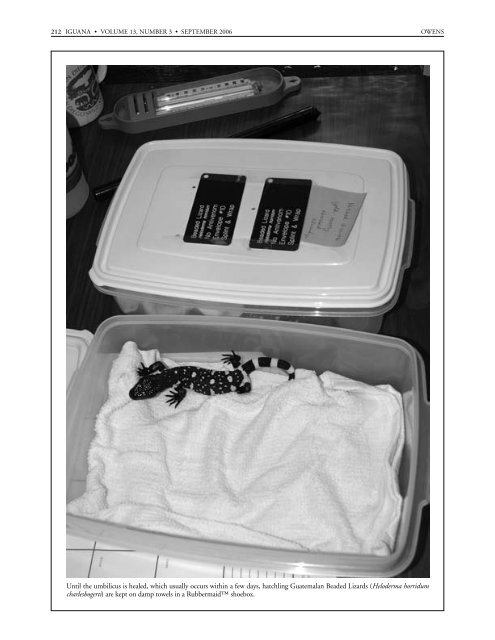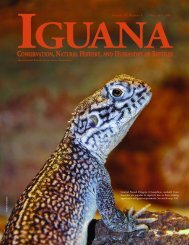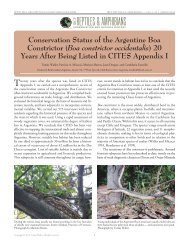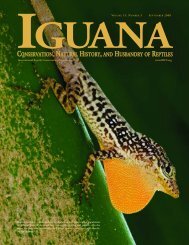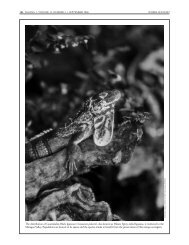Iguana13_3 Ex-Situ Notes on Reproduction Beaded Lizard.pdf
Iguana13_3 Ex-Situ Notes on Reproduction Beaded Lizard.pdf
Iguana13_3 Ex-Situ Notes on Reproduction Beaded Lizard.pdf
Create successful ePaper yourself
Turn your PDF publications into a flip-book with our unique Google optimized e-Paper software.
212 IGUANA • VOLUME 13, NUMBER 3 • SEPTEMBER 2006 OWENS<br />
Until the umbilicus is healed, which usually occurs within a few days, hatchling Guatemalan <strong>Beaded</strong> <strong>Lizard</strong>s (Heloderma horridum<br />
charlesbogerti) are kept <strong>on</strong> damp towels in a Rubbermaid shoebox.
LEE GOSS<br />
GUATEMALAN BEADED LIZARDS<br />
As c<strong>on</strong>servati<strong>on</strong> strategies are developed for the Guatemalan<br />
<strong>Beaded</strong> <strong>Lizard</strong> (Heloderma horridum charlesbogerti), understanding<br />
all aspects of the life history of this species has become<br />
essential. Unfortunately, this elusive and very rare lizard has not<br />
yet presented researchers with an opportunity to observe many<br />
aspects of its reproducti<strong>on</strong> and characteristics related to hatchlings<br />
(e.g., size, weight, and colorati<strong>on</strong>). Beginning in 1986,<br />
after observing the moribund situati<strong>on</strong> in the endangered<br />
ecosystem of the Motagua Valley, Dr. J<strong>on</strong>ath<strong>on</strong> Campbell<br />
brought eleven animals into captivity as an assurance col<strong>on</strong>y.<br />
This col<strong>on</strong>y was eventually divided between the San Diego Zoo<br />
HUSBANDRY<br />
IGUANA • VOLUME 13, NUMBER 3 • SEPTEMBER 2006 213<br />
<str<strong>on</strong>g>Ex</str<strong>on</strong>g>-<str<strong>on</strong>g>Situ</str<strong>on</strong>g>: <str<strong>on</strong>g>Notes</str<strong>on</strong>g> <strong>on</strong> Reproducti<strong>on</strong> and<br />
Captive Husbandry of the<br />
Guatemalan <strong>Beaded</strong> <strong>Lizard</strong><br />
(Heloderma horridum charlesbogerti)<br />
Adult Guatemalan <strong>Beaded</strong> <strong>Lizard</strong> (Heloderma horridum charlesbogerti)<br />
at Zoo Atlanta, <strong>on</strong>e of eleven founders of an assurance col<strong>on</strong>y that has<br />
served as a paradigm of the species in nature.<br />
Thomas C. Owens<br />
San Diego Zoo<br />
Photographs by the author except where noted.<br />
and Zoo Atlanta. These eleven animals have served as a paradigm<br />
of the animals in nature, provided us with data <strong>on</strong> reproducti<strong>on</strong>,<br />
and have helped to elucidate elements of the<br />
Guatemalan <strong>Beaded</strong> <strong>Lizard</strong>’s life history.<br />
Enclosure<br />
Since their arrival at the San Diego Zoo (SDZ), the adult<br />
<strong>Beaded</strong> <strong>Lizard</strong>s (2:3) have been housed in a variety of enclosures<br />
and c<strong>on</strong>diti<strong>on</strong>s in an attempt to determine the optimum envir<strong>on</strong>mental<br />
c<strong>on</strong>diti<strong>on</strong>s needed for reproducti<strong>on</strong>. Up<strong>on</strong> arrival at<br />
SDZ, the group of H. h. charlesbogerti was housed together in<br />
a 2.3 x 3.6 m room in a quarantine facility. This room had floor<br />
heat, basking spots, and large hollow logs that served both as<br />
visual barriers and refugia. Following the quarantine period, the<br />
lizards were moved to 1.3 x 0.6 x 0.6 m glass terraria. These<br />
enclosures utilized pine-bark substrate, 1–1.5 m cork-bark<br />
tubes (hollow), and a heavy dish for water. The latter type of<br />
enclosure was in use when the first successful breeding<br />
occurred. Since not all females (n = 3) had nested, the group<br />
was moved to two 2.5 x 0.75 x 0.75 m Neodesha cages.<br />
These enclosures are plastic with screen mesh for ventilati<strong>on</strong><br />
and mesh-covered openings in the top for basking lamps and<br />
4-ft. fluorescent fixtures. With access through the fr<strong>on</strong>t, these<br />
cages also made it safer and easier to work with venomous<br />
lizards. The substrate was pine-bark mulch and the same corkbark<br />
tubes were used. These enclosures, unlike earlier models,<br />
were equipped with nest boxes for the female <strong>Beaded</strong> <strong>Lizard</strong>s.<br />
These were large Rubbermaid storage c<strong>on</strong>tainers with lids<br />
attached and 2/3-filled with Supersoil potting soil. With circular<br />
holes cut in the side large enough for adult H. h. charlesbogerti<br />
to pass in and out of the c<strong>on</strong>tainer, they also served as<br />
refugia for individuals of both sexes.<br />
Lighting/Photoperiod and Temperature<br />
In all the vivaria described in this article, <strong>Beaded</strong> <strong>Lizard</strong>s were<br />
subjected to Acrylite OP4 skylights that transmit Ultra-violet<br />
light. C<strong>on</strong>sequently, the photoperiod varied seas<strong>on</strong>ally, providing<br />
an abbreviated winter at 9:15 light-to-dark ratio and<br />
extended in the summer to 13:11. In additi<strong>on</strong>, fluorescent fix-
214 IGUANA • VOLUME 13, NUMBER 3 • SEPTEMBER 2006 OWENS<br />
Yolk storage in hatchlings with a large abdomen may be sufficient so<br />
that food will not be accepted or needed until the yolk is depleted<br />
tures utilizing a Sylvania 350 Blacklight bulb and a<br />
Philips 40w Colort<strong>on</strong>e bulb in tandem supplied artificial<br />
light. Basking lights c<strong>on</strong>sisted of 75-watt spotlight bulbs for 9<br />
hours daily. The ambient temperature varied with seas<strong>on</strong> and<br />
time of day. The daytime temperatures during the summer<br />
range from 25–29 °C and at night can drop to 23 °C. The winter<br />
daytime temperatures are slightly milder, rarely getting<br />
much higher than 26 °C and dropping as low as 20 °C. Basking<br />
spots are situated so that animals may choose to bask directly<br />
<strong>on</strong> the substrate or elevated <strong>on</strong> cage furniture (e.g. log, nest<br />
box). The basking temperatures ranged from 33 °C directly <strong>on</strong><br />
the substrate to 46 °C at the highest basking spot.<br />
Feeding<br />
When the group of adult H. h. charlesbogerti arrived at the San<br />
Diego Zoo, they did not feed readily <strong>on</strong> adult mice. If hatchlings<br />
have a large abdomen, yolk storage may be sufficient so<br />
that food will not be accepted or needed until the yolk is<br />
depleted (Burghardt and Layne 1995). Some individual animals<br />
were reluctant to feed even after the yolk mass was spent. For<br />
the adult <strong>Beaded</strong> <strong>Lizard</strong>s that would not eat, our initial feeding<br />
strategy involved forcing the nose of an adult mouse into the<br />
lizard’s mouth until the lizard began to swallow the prey <strong>on</strong> its<br />
own. At this time, subsequent mice could be fed by putting the<br />
head of another mouse into the mouth of the <strong>Beaded</strong> <strong>Lizard</strong> as<br />
it finished the prior mouse. This process took place weekly until<br />
all animals in the group began to feed <strong>on</strong> their own. Adult H.<br />
h. charlesbogerti are fed three 21–35 g adult mice weekly. This<br />
diet is offered with the same frequency throughout the year.<br />
Juveniles are fed 1–2 adult mice <strong>on</strong>ce per week. Hatchlings are<br />
started <strong>on</strong> 2–4 g newborn mice and are quickly moved to 8–15<br />
g mice. Sometimes, as with other Heloderma, some individuals<br />
are very difficult to feed for the first few meals after hatching.<br />
Even reluctant feeders can usually be induced to feed by placing<br />
a pre-killed newborn mouse at the end of forceps and<br />
touching it to the base of tail of the hatchling <strong>Beaded</strong> <strong>Lizard</strong>.<br />
The animal will spin around defensively. This procedure is<br />
repeated until the lizard bites the newborn mouse defensively<br />
and then begins to swallow.<br />
Breeding<br />
Since the 1970s, with helodermatid lizards reproducing infrequently<br />
in captivity, the reproductive habits of <strong>Beaded</strong> <strong>Lizard</strong>s<br />
have been slowly revealed, but difficult to assimilate into a successful<br />
breeding program. Sexing H. h. charlesbogerti using previously<br />
described ultrasound sexing techniques (Morris and<br />
Alberts 1996, Morris and Henders<strong>on</strong> 1998) was problematic<br />
due to enlarged preanal plates and thick scalati<strong>on</strong>. The populati<strong>on</strong><br />
of H. h. charlesbogerti housed at SDZ is comprised of two<br />
males and three females. Since the time that they were housed<br />
together as a group in quarantine, many combinati<strong>on</strong>s of total<br />
numbers and sexes were utilized in an attempt to stimulate<br />
breeding. Attempted combinati<strong>on</strong>s included <strong>on</strong>e male and <strong>on</strong>e<br />
female, <strong>on</strong>e male and two females, and isolating males from<br />
females entirely until the breeding seas<strong>on</strong>, when they are reintroduced.<br />
Two females have produced eggs and <strong>on</strong>ly <strong>on</strong>e male<br />
has been observed breeding. The sizes of the two reproductive<br />
females are 43.2 cm snout-vent length (SVL), 72.4 cm total<br />
length (TL), 1.8 kg and 40.9 cm SVL, 74.3 cm TL, 1.5 kg,<br />
respectively. The n<strong>on</strong>reproductive female is smaller. The size of<br />
the reproductive male is 47.9 cm SVL, 81.0 cm TL, and 2.1 kg.<br />
The other male is smaller. Breeding has been observed <strong>on</strong> many<br />
occasi<strong>on</strong>s during July and August. At SDZ, we have never<br />
observed combat behavior between males either in situati<strong>on</strong>s<br />
where two males are living together or where they are introduced<br />
just prior to being paired with a female. Zoo Atlanta has<br />
reported seeing very intense male combat behavior <strong>on</strong> multiple<br />
occasi<strong>on</strong>s (B. Lock, pers. comm.) At SDZ, males will sometimes<br />
refuse prey for 2–3 weeks during the breeding seas<strong>on</strong>.<br />
Hatchling Guatemalan <strong>Beaded</strong> <strong>Lizard</strong>s (Heloderma horridum charlesbogerti)<br />
have 4–5 broad yellow tail bands separated by black bands.<br />
After some experimentati<strong>on</strong>, clutches are incubated <strong>on</strong> mixtures that<br />
are slightly drier than a 1:1 water-to-vermiculite ratio.
GUATEMALAN BEADED LIZARDS<br />
Eggs and Incubati<strong>on</strong><br />
While eggs were yielded in all the enclosure types described<br />
above, viable eggs were obtained <strong>on</strong>ly in the latter two. Reports<br />
indicate that egg-laying for H. h. charlesbogerti in the wild<br />
begins in late October and early November (Campbell and<br />
Vannini 1988, Ariano 2003, Beck 2005). At SDZ, we have had<br />
eggs produced from the end of September until the beginning<br />
of January. Clutch size for adult females<br />
(n = 2) has ranged from 5–10 eggs with a mean clutch size of<br />
8 (n = 8). In all three types of enclosures provided at SDZ, nesting<br />
has been problematic. Although females have layed in a nest<br />
box, they seem to scatter the eggs <strong>on</strong> the substrate, and will lay<br />
in or behind the hollow logs even when provided with deep soil<br />
in a variety of nest boxes. The first four clutches were set up in<br />
a 1:1 water-to-vermiculite mixture. The fourth clutch of 10<br />
eggs, was incubated at 30 °C (86 °F), and four eggs hatched<br />
after an incubati<strong>on</strong> period of 145–148 days (Owens et al.<br />
2003). At a <strong>on</strong>e-m<strong>on</strong>th interval, this clutch of eggs was candled<br />
and vascularizati<strong>on</strong> was well developed. Embryos approximately<br />
2 cm in length were observed in five of the eggs. About two<br />
m<strong>on</strong>ths into incubati<strong>on</strong>, <strong>on</strong>e egg with an embryo ruptured and<br />
failed to hatch. Incubati<strong>on</strong> media were modified to a 1:2 waterto-vermiculite<br />
mixture for the next two clutches. Both of these<br />
clutches began to dehydrate after <strong>on</strong>ly two m<strong>on</strong>ths of incubati<strong>on</strong>.<br />
So, clutches seven and eight were set-up just slightly drier<br />
than a 1:1 water-to-vermiculite ratio. Due to infertility, <strong>on</strong>e of<br />
these clutches deteriorated immediately. The last clutch of six<br />
eggs was incubated at 28 °C (82 °F). Two of the eggs successfully<br />
hatched after 163 and 164 day incubati<strong>on</strong> periods. This<br />
incubati<strong>on</strong> period is c<strong>on</strong>siderably shorter than that reported for<br />
other subspecies of <strong>Beaded</strong> <strong>Lizard</strong>s (Ramirez-Bautista 1994).<br />
Hatching<br />
Hatching success has occurred in two different clutches. The<br />
first event occurred in May 2003 and the sec<strong>on</strong>d in March<br />
2006. Once slitting the egg, each hatchling took anywhere from<br />
1–2 days to fully emerge. Little to no yolk was visible externally<br />
at time of emergence. Until the umbilicus is healed, which is<br />
usually within a few days, the hatchlings are kept <strong>on</strong> damp tow-<br />
Once eggs are slit, hatchlings take anywhere from 1–2 days to fully<br />
emerge.<br />
IGUANA • VOLUME 13, NUMBER 3 • SEPTEMBER 2006 215<br />
Hatchling Guatemalan <strong>Beaded</strong> <strong>Lizard</strong> (Heloderma horridum charlesbogerti).<br />
els in a Rubbermaid shoebox. All hatchlings (n = 6), from<br />
two different females, ranged in SVL from 119–124.9 mm<br />
(197–208 mm TL) and weighed 33.5–37.0 g. Colorati<strong>on</strong> of the<br />
young is much like that of other forms of Heloderma horridum.<br />
Instead of 4–5 pairs of distinct yellow tail rings separated by<br />
black bands, the hatchlings have 4–5 broad yellow bands separated<br />
by black bands.<br />
Acknowledgements<br />
I am most grateful to D<strong>on</strong> Boyer for his encouragement, support,<br />
and his endless enthusiasm for this species. I also thank<br />
John Kinkaid and the rest of the staff in the Department of<br />
Herpetology at the San Diego Zoo for their collegial support.<br />
For her enriching comments <strong>on</strong> this manuscript, I thank AJ<br />
Gutman, and for her comments and humble support of a<br />
mutual passi<strong>on</strong>, I thank Melissa Owens.<br />
Literature Cited<br />
Ariano, D. 2003. Distribución e Historia Natural del Escorpión Heloderma horridum<br />
charlebogerti Campbell y Vannini (Sauria: Helodermatidae) en<br />
Zacapa, Guatemala y Caracterización de su Veneno. Licenciatura Thesis,<br />
Universidad del Valle de Guatemala, Guatemala.<br />
Beck, D.D. 2005. Biology of Gila M<strong>on</strong>sters and <strong>Beaded</strong> <strong>Lizard</strong>s. University of<br />
California Press, Berkley and Los Angeles.<br />
Burghardt, G.M. and D. Layne. 1995. Effects of <strong>on</strong>togenetic processes and rearing<br />
c<strong>on</strong>diti<strong>on</strong>s, pp. 165–180. In: C. F. Warwick, F. Frye, and J. Murphy<br />
(eds.), Health and Welfare of Captive Reptiles. Chapman and Hall, L<strong>on</strong>d<strong>on</strong>.<br />
Campbell, J. and J. Vannini. 1988. A new subspecies of beaded lizard,<br />
Heloderma horridum, from the Motagua Valley of Guatemala. Journal of<br />
Herpetology 22:457–468.<br />
Morris, P.J. and A.C. Alberts. 1996. Determinati<strong>on</strong> of sex in White-throated<br />
M<strong>on</strong>itors (Varanus albigularis), Gila M<strong>on</strong>sters (Heloderma suspectum), and<br />
<strong>Beaded</strong> <strong>Lizard</strong>s (Heloderma horridum) using two-dimensi<strong>on</strong>al ultrasound<br />
imaging. Journal of Zoo and Wildlife Medicine 27:371–377.<br />
Morris, P.J. and C. Henders<strong>on</strong>. 1998. Gender determinati<strong>on</strong> in mature Gila<br />
M<strong>on</strong>sters, Heloderma suspectum, and Mexican <strong>Beaded</strong> <strong>Lizard</strong>s, Heloderma<br />
horridum, by ultrasound imaging of the ventral tail. Bulletin of the<br />
Associati<strong>on</strong> of Reptilian and Amphibian Veterinarians 8:4–5.<br />
Owens, T., C.B. Downer, and D.M. Boyer. 2003. Successful reproducti<strong>on</strong> of<br />
the Guatemalan <strong>Beaded</strong> <strong>Lizard</strong> (Heloderma horridum charlesbogerti) at the<br />
San Diego Zoo. Unpublished notes.<br />
Ramírez-Bautista, A. 1994. Manual y Claves Ilustradas de los Anfibios y<br />
Reptiles de la Regi<strong>on</strong> de Chamela, Jalisca, México. Universidad Naci<strong>on</strong>al<br />
Autónoma de México, México, D.F.


